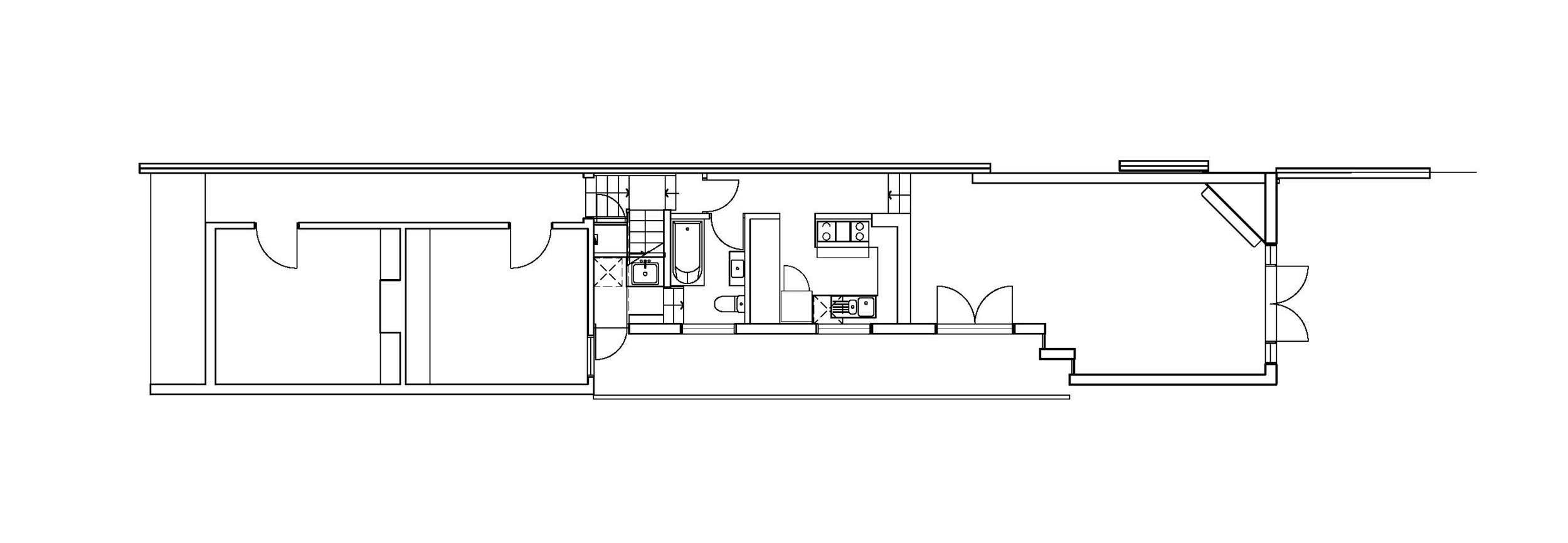Passage
by Honeyman and Smith

Throughout Passage by Honeyman and Smith natural light is encouraged from above and the side, as it is disperesed beautfiully through new and existing openings.
Light is a key feature for the design of Passage. Elements of cork dapples the indirect light, glass balusters capture and hold it like a candle, and lime based paint contains the light to layered, existing surfaces.
Thomas Honeyman and Sara Smith of Honeyman and Smith wanted to connect the occupant with the hallway in an attempt to slow down the typical rushed transition. The change of state from outside to inside is now visually linked from front to back. Hallways, stairways, landings, entries are no longer isolated experiences, they are vestibules connected by replanning and additions in order to psychologically connect the occupant with the place they have chosen as their home.
Light is a key feature for the design of Passage by Honeyman and Smith.
The existing conditions of the Victorian terrace house in Melbourne’s inner suburb of Princes Hill, provided a combination of Victorian grandeur of scale and materiality. The exisiting 1980s era rear extension provided several design challenges in the form of multiple rises and falls between spaces, clustered programming, lack of natural light (synonymous with terrace houses), vast, under-utilised spaces and an elevated unwelcoming kitchen.
Elements of cork dapples the indirect light, glass balusters capture and hold it like a candle, and lime based paint contains the light to layered, existing surfaces.
Honeyman and Smith’s highly resolved and rationalised response sought to promote and celebrate key features of the Victorian terrace house, including the original staircase, high ceilings, ornamental detail and connection to rear garden and light well. Order was then reinstated through the elimination of an unnecessary changes in level in the kitchen, bathroom and laundry.
The existing conditions of the Victorian terrace house in Melbourne’s inner suburb of Princes Hill, provided a combination of Victorian grandeur of scale and materiality.
Access from the front door to the rear garden is now achievable on one level, without interrupting doors or program, the concept of ‘passage’ was achieved with a new infill concrete slab connecting the original terrace hallway to the shell of the 1980s extension. Key program elements were relocated in a light filled extension in the southern light well, housing a laundry, bathroom and separate shower, which can open and close depending on use in order to provide borrowed light to the corresponding dark party wall.
Psychologically connect the occupant with the place they have chosen as their home.
The circulation of the new scheme present in Passage promotes and celebrates the heritage staircase, following the removal of cupboards and stair additions. A furhter careful refurbishment of the staircase created enough space to transition underneath and experience the original structure and materials. Original brickwork and later steel additions have also been exposed and promoted throughout the home.
The circulation of the new scheme present in Passage promotes and celebrates the heritage staircase.
Throughout Passage by Honeyman and Smith natural light is encouraged from above and the side, as it is disperesed beautfiully through new and existing openings.
Light is a key feature for the design of Passage. Elements of cork dapples the indirect light, glass balusters capture and hold it like a candle, and lime based paint contains the light to layered, existing surfaces.
Thomas Honeyman and Sara Smith of Honeyman and Smith wanted to connect the occupant with the hallway in an attempt to slow down the typical rushed transition. The change of state from outside to inside is now visually linked from front to back. Hallways, stairways, landings, entries are no longer isolated experiences, they are vestibules connected by replanning and additions in order to psychologically connect the occupant with the place they have chosen as their home.
Light is a key feature for the design of Passage by Honeyman and Smith.
The existing conditions of the Victorian terrace house in Melbourne’s inner suburb of Princes Hill, provided a combination of Victorian grandeur of scale and materiality. The exisiting 1980s era rear extension provided several design challenges in the form of multiple rises and falls between spaces, clustered programming, lack of natural light (synonymous with terrace houses), vast, under-utilised spaces and an elevated unwelcoming kitchen.
Elements of cork dapples the indirect light, glass balusters capture and hold it like a candle, and lime based paint contains the light to layered, existing surfaces.
Honeyman and Smith’s highly resolved and rationalised response sought to promote and celebrate key features of the Victorian terrace house, including the original staircase, high ceilings, ornamental detail and connection to rear garden and light well. Order was then reinstated through the elimination of an unnecessary changes in level in the kitchen, bathroom and laundry.
The existing conditions of the Victorian terrace house in Melbourne’s inner suburb of Princes Hill, provided a combination of Victorian grandeur of scale and materiality.
Access from the front door to the rear garden is now achievable on one level, without interrupting doors or program, the concept of ‘passage’ was achieved with a new infill concrete slab connecting the original terrace hallway to the shell of the 1980s extension. Key program elements were relocated in a light filled extension in the southern light well, housing a laundry, bathroom and separate shower, which can open and close depending on use in order to provide borrowed light to the corresponding dark party wall.
Psychologically connect the occupant with the place they have chosen as their home.
The circulation of the new scheme present in Passage promotes and celebrates the heritage staircase, following the removal of cupboards and stair additions. A furhter careful refurbishment of the staircase created enough space to transition underneath and experience the original structure and materials. Original brickwork and later steel additions have also been exposed and promoted throughout the home.
![Book Flatlay Cover Front Transparent Trio[1]](https://d31dpzy4bseog7.cloudfront.net/media/2024/06/07080212/Book_Flatlay_Cover_Front_Transparent_Trio1.png)















































